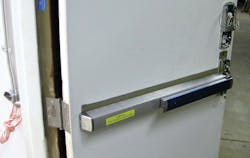This is the challenge locksmiths face with virtually every electronic access control project: creating a system that provides the customer’s security requirements while satisfying the Life Safety and Fire Codes.
Life Safety Codes address the concerns of providing safe egress from the premises. Fire Codes address the concerns of mitigating the spread of smoke and flames throughout a premises.
Electronic security and electronic access control systems are intended to provide that other side of safety: “Keeping the Bad Guys Out.”
Several standards and codes provide guidelines for the design of security and access control systems, and their proper deployment. Government entities, corporations and institutions will cite these, or use these standards as a criteria for specifying systems.(see my article “Codes & Standards That Matter” that appeared in the October 2011 Locksmith Ledger)
Fire Doors & the Means of Egress
Since our systems provide security and typically involve perimeter doors, it is likely doors to which you plan to apply access control will be along the means of egress and possibly fire doors as well. Fire doors, also referred to as labeled doors, are assemblies or systems comprised of the door, frame and hardware. The rating of the fire door is determined by the occupancy of the structure and the wall construction.
Did you know the rating of a fire door is typically three-quarters of the rating of the wall into which the door sits? For example a four hour wall would utilize a 3 hour door. The reason is that it is assumed that the door will be kept clear, while the walls may have objects, merchandise (a/k/a combustibles) piled up against them.
Unless someone is walking through it, a fire door must be closed and latched. This means the fire door must have a functional door closer or spring hinges, and a latch.
There is no requirement in the life safety code that the door be locked. If a fire door is locked, the lock cannot inhibit egress, only ingress.
Fire doors in stairwells that are means of egress cannot be locked from either side if there is the fire alarm system is in alarm mode. It must be unlocked automatically in a fire.
If you are planning to control entry from a stairwell onto a floor, you must provide for this functionality, and understand the difference between locked and latched. Building Codes vary. Check with your local authority having jurisdiction (LAHJ).
“Means of Egress”
Egress doors are part of the Means of Egress. The “means of egress” is a continuous and unobstructed path of egress travel from any occupied portion of a building or structure to a public way. A means of egress is considered a system comprised of three parts: exit access, exit, and exit discharge.
Exit access is “that portion of the means of egress system that leads from an occupied portion of a building or structure to an exit.” It includes halls, corridors, aisles, and other walking or escape paths.
The exit is “that portion of a means of egress system which is separated from other interior spaces of a building or structure by fire-resistance rated construction and opening protectives as required to provide a protected path if egress travel between the exit access and exit discharge.”
The exit discharge is that portion of a means of egress system between the termination of an exit and a public way which is a street, alley, or other parcel dedicated for public use.
Occupancy Considerations
Occupancy describes the use or intended use of a building or part of the building. The type of hardware acceptable for a particular opening will be contingent on the building’s occupancy. Verify this information to be certain the hardware you are supplying conforms to the requirements set forth for the particular occupancy.
I recommend that you ask your AHJ to verify the hardware requirements for all situations where you have any doubts.
Safety and Security Case History
This month’s case history is a perfect example of balancing security and life safety. We supplied access control for doors with panic hardware in a renovated space. Our solutions were the Schlage AD 300 Networked Standalone Locks for security and the Von Duprin 98EO-F Rim Exit Devices for life safety.
Von Duprin 98 and 99 Rim Exit Devices are for all types of single and double doors with mullion, UL listed for Panic Exit Hardware. Von Duprin 98-F and 99-F Rim Fire Exit Devices are for all types of single doors up to 4´ x 10´ or 8´ x 10’ double doors with 9954 or 9854 mullion, UL listed for Fire Exit Hardware. (NOTE: not all fire doors are listed for use with Fire Exit Hardware)
Devices are ANSI A156.3 – 2001 Grade 1. The 98 device has a smooth mechanism case and the 99 device has a grooved case. The rim device is non-handed except when SD or SS options are used.
Schlage AD 300 Networked Standalone Locks were specified with MT (multi-technology readers) in the event the end-user wanted to migrate to smart cards someday to enhance security. We also specified interchangeable core levers so the client could easily key the doors to their existing key system.
The AD series was designed to be flexible, adaptable and scalable - just what we needed for this job, which was one of several city buildings which utilized access control.
All buildings which had been upgraded to the Schlage Security Management System were tied together through the Municipal LAN. Sites already on line included City Hall, The Court, The School Transportation Garage, The Public Transit Hub, and Police Department Headquarters. This case history project was an offsite police facility.
Schlage SMS offers a mature software suite, and many locking solutions making it one of the most flexible lines available. This flexibility allowed us to outfit doors using pre-existing locking hardware and door preps.
We used both The AD-300993R x 70 x MT x RHO x 626 x PDC123 on two doors, and the AD-300MS x70 x MT x RHO x 626 x PDC123 on a third door.
A hardwired networked solution gives you instant control of your system. The AD-Series combines all the hardware components required for a complete access control system into one integrated design that includes the electrified lock, credential reader, request-to-enter and -exit sensors, door position switch and more. This integrated design saves you both time and money when installing your system.
To provide you with more information about what is going on at each of your openings, a number of status indicators can be monitored remotely. Each opening can be customized using the large number of options the AD-Series has to offer.
We hard-wired each AD-300 to the SMS SCRNX-R controller which connects via RJ-45 directly into the LAN. On other installations where existing locksets and electric strikes were requested, we used Schlage SRINX controllers and cards readers (MT) wired back to a SCRNX-R. On another site, where running wire would have been impractical, the wireless version of the AD, the AD-400 Series was deployed.
On all doors, the end-user encounters a familiar and friendly interface. All administrators use a uniform and organized GUI (Graphical user Interface) with common attributes. Each manager’s administrative privileges are tailored exactly to each manager’s requirements, and, if required, real time reporting, and global control functions such as lockdown are immediately available.
We have found that although customers demand real time interface, unless there are full time guards, most usually do not have time to use it except for special events and occasional credential and system function housekeeping when having the feature pays off and saves valuable time.
With all the various departments using the same software management system, training of new users on card holder administration and scheduling and other tasks is simplified and often undertaken in-house by the Facilities Department.






